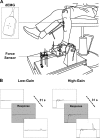Visual information processing in older adults: reaction time and motor unit pool modulation
- PMID: 30207861
- PMCID: PMC6295548
- DOI: 10.1152/jn.00161.2018
Visual information processing in older adults: reaction time and motor unit pool modulation
Abstract
Presently, there is no evidence that magnification of visual feedback has motor implications beyond impairments in force control during a visuomotor task. We hypothesized that magnification of visual feedback would increase visual information processing, alter the muscle activation, and exacerbate the response time in older adults. To test this hypothesis, we examined whether magnification of visual feedback during a reaction time task alters the premotor time and the motor unit pool activation of older adults. Participants responded as fast as possible to a visual stimulus while they maintained a steady ankle dorsiflexion force (15% maximum) either with low-gain or high-gain visual feedback of force. We quantified the following: 1) response time and its components (premotor and motor time), 2) force variability, and 3) motor unit pool activity of the tibialis anterior muscle. Older adults exhibited longer premotor time and greater force variability than young adults. Only in older adults, magnification of visual feedback lengthened the premotor time and exacerbated force variability. The slower premotor time in older adults with high-gain visual feedback was associated with increased force variability and an altered modulation of the motor unit pool. In conclusion, our findings provide novel evidence that magnification of visual feedback also exacerbates premotor time during a reaction time task in older adults, which is correlated with force variability and an altered modulation of motor unit pool. Thus these findings suggest that visual information processing deficiencies in older adults could result in force control and reaction time impairments. NEW & NOTEWORTHY It is unknown whether magnification of visual feedback has motor implications beyond impairments in force control for older adults. We examined whether it impairs reaction time and motor unit pool activation. The findings provide novel evidence that magnification of visual feedback exacerbates reaction time by lengthening premotor time, which implicates time for information processing in older adults, which is correlated with force variability and an altered modulation of motor unit pool.
Keywords: aging; electromyogram decomposition; force variability; motor unit activity; reaction time.
Figures





Similar articles
-
Visual Information Processing in Older Adults: Force Control and Motor Unit Pool Modulation.J Mot Behav. 2024;56(3):330-338. doi: 10.1080/00222895.2023.2298888. Epub 2023 Dec 28. J Mot Behav. 2024. PMID: 38155098 Free PMC article.
-
Motor output oscillations with magnification of visual feedback in older adults.Neurosci Lett. 2017 Apr 24;647:8-13. doi: 10.1016/j.neulet.2017.03.011. Epub 2017 Mar 12. Neurosci Lett. 2017. PMID: 28300635
-
Visual load and variability of muscle activation: Effects on reactive driving of older adults.Hum Mov Sci. 2019 Feb;63:172-181. doi: 10.1016/j.humov.2018.11.018. Epub 2018 Dec 15. Hum Mov Sci. 2019. PMID: 30562674
-
Mechanisms that contribute to differences in motor performance between young and old adults.J Electromyogr Kinesiol. 2003 Feb;13(1):1-12. doi: 10.1016/s1050-6411(02)00084-6. J Electromyogr Kinesiol. 2003. PMID: 12488083 Review.
-
Aging and variability of voluntary contractions.Exerc Sport Sci Rev. 2011 Apr;39(2):77-84. doi: 10.1097/JES.0b013e31820b85ab. Exerc Sport Sci Rev. 2011. PMID: 21206281 Free PMC article. Review.
Cited by
-
Bilateral ankle dorsiflexion force control impairments in older adults.PLoS One. 2025 Mar 20;20(3):e0319578. doi: 10.1371/journal.pone.0319578. eCollection 2025. PLoS One. 2025. PMID: 40112015 Free PMC article.
-
Visual Information Processing in Older Adults: Force Control and Motor Unit Pool Modulation.J Mot Behav. 2024;56(3):330-338. doi: 10.1080/00222895.2023.2298888. Epub 2023 Dec 28. J Mot Behav. 2024. PMID: 38155098 Free PMC article.
-
Implications of Intra-Individual Variability in Motor Performance on Functional Mobility in Stroke Survivors.Geriatrics (Basel). 2025 Mar 24;10(2):51. doi: 10.3390/geriatrics10020051. Geriatrics (Basel). 2025. PMID: 40277850 Free PMC article.
References
-
- Chang SS, De Luca CJ, Nawab S.Aliasing rejection in precision decomposition of EMG signals. Annual International Conference of the IEEE Engineering in Medicine and Biology Society IEEE Engineering in Medicine and Biology Society Annual Conference. Vancouver, BC, Canada, August 20–24 2008, p. 4972–4975. - PubMed
Publication types
MeSH terms
Grants and funding
LinkOut - more resources
Full Text Sources
Other Literature Sources
Medical

